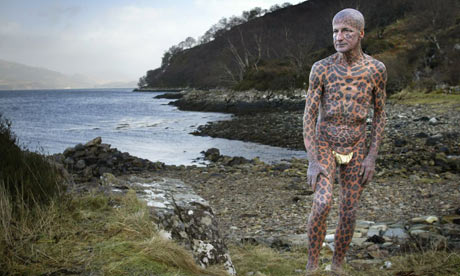As years go by, even from an early age, we all make adjustments, we all accommodate, we all shift to make ourselves more comfortable.
The UK Guardian newspaper online carried a wonderful article, and an even more wonderful photograph, about a shift in the life of Tom Leppard, the leopard man of Skye, now that he’s 73.
Tom Leppard the leopard man of Skye. Photograph: Murdo Macleod
The article tells us that;
The leopard man has been domesticated. After 20 years of living in the wilds on a remote part of Skye, the man made famous for his leopard tattoos has changed his spot for a one-bedroom apartment. At 73, Tom Leppard was starting to feel his age, and the weekly kayak trip across the fast-flowing Kyles of Lochalsh for supplies was taking its toll. He was “one big wave away from disaster”, and when a friend offered him the chance to leave the shore of Loch na Bèiste for the comfort of four walls in the village of Broadford, he leapt at the chance.
So Tom Leppard has shifted to new accommodation.
The brilliant article and even more brilliant photograph leave me with two lines of thought that I would like to follow up in subsequent posts.
The first line of thought is about all those dualities that we have to balance and adjust to maintain our sense of who we are. There are many – here are just a few; me-not me, my space-not my space, embrace-intrusion, willed change v. forced change, now-not now, my identity as derived from my memories-the terror of not being, identifying with v. dis-identifying with, being inside v. being outside, a sense of perfect place v a sense of alienating place, my group-not my group, being part of a salad v. being part of a soup, and many, many more.
All of these dualities around the issue of identity go much further and deeper when we compare and contrast this discussion with the pereenial nowness, no-dual philosophy of such writer-teachers as Ken Wilber or Eckhart Tolle.
The second line of thought concerns the genius of the photograph per se.
Both lines of thought I see as fascinating for philosophical inquiry and creativity lessons with children or adults – starting with this article and photograph.


